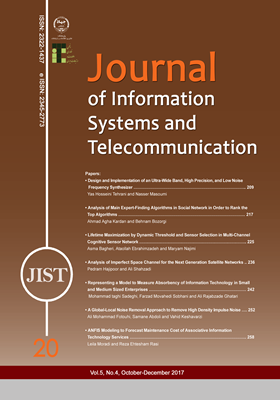-
-
List of Articles
-
Open Access Article
1 - Better performance of special triangular constellations for the OFDM systems in complicated fading channel
saeed ghazi-maghrebi -
Open Access Article
2 - Analysis of expert finding algorithms in social network in order to rank the top algorithms
AhmadAgha kardan Behnam Bozorgi -
Open Access Article
3 - Design and Implementation of an Ultra-Wide Band, High Precision, and Low Noise Frequency Synthesizer
Yas Hosseini Tehrani Nasser Masoumi -
Open Access Article
4 - Analysis of Imperfect Space Channel for the Next Generation Satellite Networks
pedram hajipour ali shahzadi -
Open Access Article
5 - Lifetime Maximization by Dynamic Threshold and Sensor Selection in Multi-channel Cognitive Sensor Network
Asma Bagheri Ataollah Ebrahimzadeh maryam najimi -
Open Access Article
6 - A Global-Local Noise Removal Approach to Remove High Density Impulse Noise
Ali Mohammad Fotouhi Samane Abdoli Vahid Keshavarzi -
Open Access Article
7 - Representing a Model to Measure Absorbency Of Information Technology in Small And Medium Sized Enterprises
Mohammad Taghi Sadeghi Farzad Movahedi Sobhani Ali Rajabzade Ghatari -
Open Access Article
8 - ANFIS Modeling to Forecast Maintenance Cost of Associative Information Technology Services
Reza Ehtesham Rasi Leila Moradi
-
The rights to this website are owned by the Raimag Press Management System.
Copyright © 2017-2025







